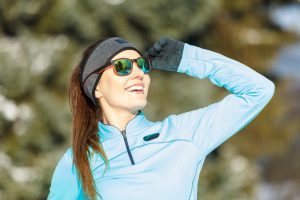Mass. Eye and Ear Ophthalmologist Ryan Vasan, MD, offers winter sports enthusiasts valuable information on snow blindness.
What is snow blindness?
Snow blindness, or photokeratitis, is essentially a sunburn to the front of the eye, consisting of the cornea and conjunctiva. It’s caused by overexposure to ultraviolet rays, and it’s more common in those who participate in winter sports.
“When you’re skiing, snowboarding or snowmobiling, the ultraviolet light reflects off the snow so you get a double hit of ultraviolet light when added to the direct rays from the sun,” explained Ryan Vasan, MD, an ophthalmologist at Mass. Eye and Ear. “Plus, ultraviolet light is stronger at higher altitudes.”
What are the symptoms?
Some common symptoms of snow blindness are pain, light sensitivity, irritation and excess tears. Symptoms usually improve within 48 hours.
“The problem with snow blindness is that, just like with a sunburn, you don’t have the symptoms right away,“ Dr. Vasan says. “You get the symptoms hours later when your body starts to repair itself and creates inflammation, so it can be difficult to put the two together and to recognize that the cause of the problem was the sun exposure you experienced hours ago.”

How do I treat it?
At home, you can use lubricating drops like artificial tears, keep your eyes closed or take oral ibuprofen (such as Advil) for any pain.
“I usually give patients anti-inflammatory drops,“ Dr. Vasan says. “Snow blindness is very painful. While it’s not likely going to cause permanent damage, it can really sideline you as it’s very hard to do anything when you can’t keep your eyes open.”
How do I prevent it?
Wear glasses or goggles that offer 100 percent ultraviolet protection and have polarized lenses, which help reduce snow glare.
“Just like welders wear a protective mask to shield them from ultraviolet light exposure that can be harmful to the eye,” Dr. Vasan says. “We can do something similar by wearing protective goggles when we participate in winter sports. Goggles also keep cold air and foreign bodies out of your eye, which is especially important when you’re skiing down a mountain at 10 to 20 miles an hour or traveling even faster on a snowmobile.”
About our expert
 Dr. Ryan Vasan is an ophthalmologist at Mass. Eye and Ear who specializes in cataracts and dry eye. He sees patients at two locations: Longwood (800 Huntington Avenue) and Stoneham (1 Montvale Avenue).
Dr. Ryan Vasan is an ophthalmologist at Mass. Eye and Ear who specializes in cataracts and dry eye. He sees patients at two locations: Longwood (800 Huntington Avenue) and Stoneham (1 Montvale Avenue).